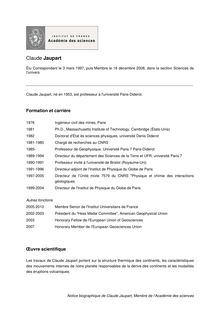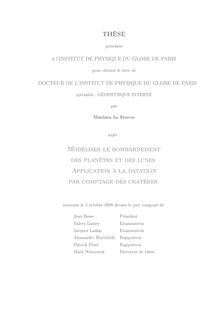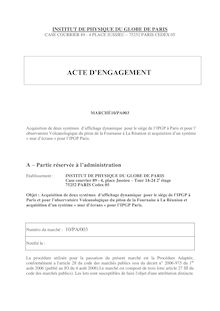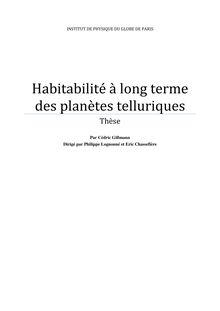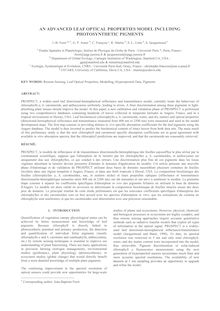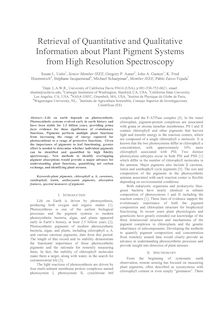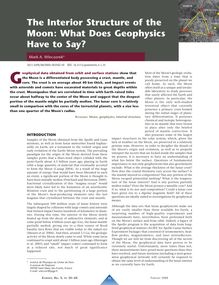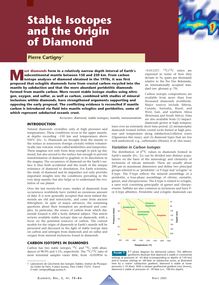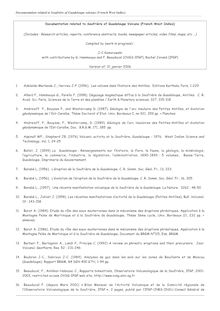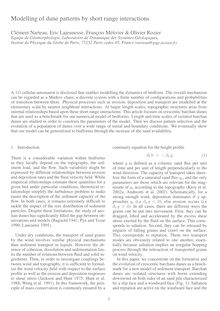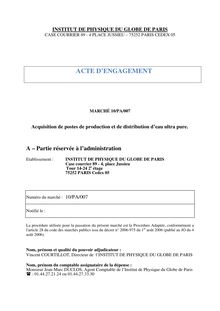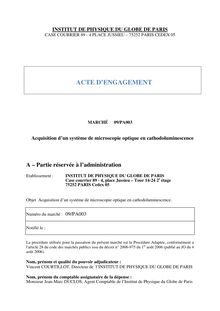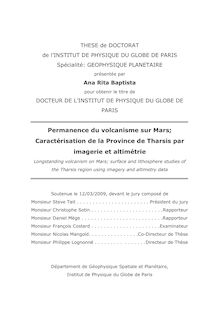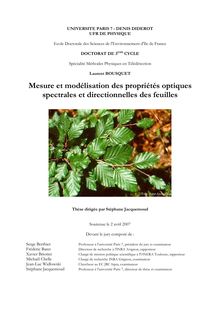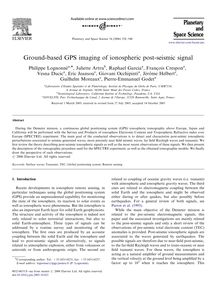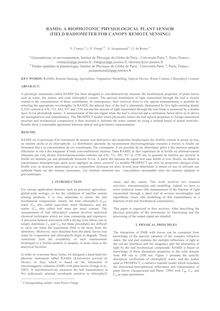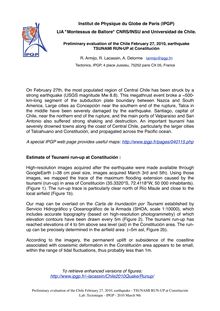#institut-de-physique-du-globe-de-paris
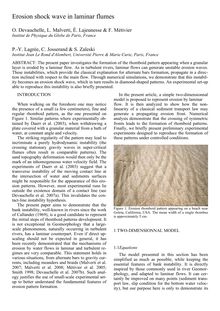
Documents
INTRODUCTION When walking on the foreshore one may notice the presence of a small a few centimeters fine and regular rhomboid pattern as the one presented on Figure Similar patterns where experimentally ob tained by Daerr et al when withdrawing a plate covered with a granular material from a bath of water at constant angle and velocity The striking regularity of the pattern may lead to incriminate a purely hydrodynamic instability the crossing stationary gravity waves in super critical flumes often result in comparable patterns The sand topography deformation would then only be the mark of an inhomogeneous water velocity field The experiments of Daerr et al suggest that a transverse instability of the moving contact line at the intersection of water and sediments surfaces might be responsible for the appearance of this ero sion patterns However most experimental runs lie outside the existence domain of a contact line see Devauchelle et al 2007a This invalidates the con tact line instability hypothesis The present paper aims to demonstrate that the bank instability well known in rivers since the work of Callander is a good candidate to represent the initial steps of rhomboid patterns development It is not exceptional in Geomorphology that a large scale phenomenon naturally occurring in turbulent rivers has a laminar counterpart Even if direct up scaling should not be expected in general it has been recently demonstrated that the mechanisms of erosion by water flows in laminar and turbulent re gimes are very comparable This statement holds in various situations from alternate bars to gravity cur rents including meanders and braids Malverti et al Malverti et al Métivier et al Smith Devauchelle et al 2007b Such anal ogy justifies the use of small scale experimental set up to better understand the fundamental features of erosion pattern formation
Jean Le Rond

Documents
Education
INTRODUCTION When walking on the foreshore one may notice the presence of a small a few centimeters fine and regular rhomboid pattern as the one presented on Figure Similar patterns where experimentally ob tained by Daerr et al when withdrawing a plate covered with a granular material from a bath of water at constant angle and velocity The striking regularity of the pattern may lead to incriminate a purely hydrodynamic instability the crossing stationary gravity waves in super critical flumes often result in comparable patterns The sand topography deformation would then only be the mark of an inhomogeneous water velocity field The experiments of Daerr et al suggest that a transverse instability of the moving contact line at the intersection of water and sediments surfaces might be responsible for the appearance of this ero sion patterns However most experimental runs lie outside the existence domain of a contact line see Devauchelle et al 2007a This invalidates the con tact line instability hypothesis The present paper aims to demonstrate that the bank instability well known in rivers since the work of Callander is a good candidate to represent the initial steps of rhomboid patterns development It is not exceptional in Geomorphology that a large scale phenomenon naturally occurring in turbulent rivers has a laminar counterpart Even if direct up scaling should not be expected in general it has been recently demonstrated that the mechanisms of erosion by water flows in laminar and turbulent re gimes are very comparable This statement holds in various situations from alternate bars to gravity cur rents including meanders and braids Malverti et al Malverti et al Métivier et al Smith Devauchelle et al 2007b Such anal ogy justifies the use of small scale experimental set up to better understand the fundamental features of erosion pattern formation
Jean Le Rond
4 pages
English
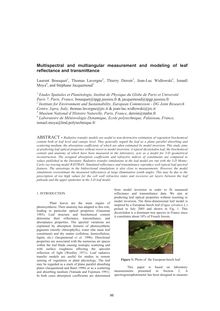
Documents
Multispectral and multiangular measurement and modeling of leaf reflectance and transmittance Laurent Bousquet1 Thomas Lavergne2 Thierry Deroin3 Jean Luc Widlowski2 Ismaël Moya4 and Stéphane Jacquemoud1 Etudes Spatiales et Planétologie Institut de Physique du Globe de Paris et Université Paris Paris France jussieu fr jussieu fr Institute for Environment and Sustainability European Commission DG Joint Research Centre Ispra Italy thomas it jean luc it Muséum National d'Histoire Naturelle Paris France fr Laboratoire de Météorologie Dynamique Ecole polytechnique Palaiseau France ismael polytechnique fr ABSTRACT Radiative transfer models are useful to non destructive estimation of vegetation biochemical content both at leaf level and canopy level They generally regard the leaf as a plane parallel absorbing and scattering medium the absorption coefficients of which are often estimated by model inversion This study aims at predicting leaf optical properties without resort to model inversion A typical dicotyledon leaf the biochemical content and anatomy of which have been measured in the laboratory acts as a model for D geometrical reconstruction The assigned absorption coefficients and refractive indices of constituents are compared to values published in the literature Radiative transfer simulations in the leaf model are run with the D Monte Carlo ray tracing model RAYTRAN Simulated reflectance and transmittance reproduce well typical leaf spectral features The anisotropy in the bidirectional simulations is also close to measurements However the model simulations overestimate the measured reflectances at large illumination zenith angles This may be due to the prescription of too high values for the cell wall refractive index and excessive air layers between the leaf palisade and the upper epidermis in the D leaf model
Stéphane

Documents
Etudes supérieures
Multispectral and multiangular measurement and modeling of leaf reflectance and transmittance Laurent Bousquet1 Thomas Lavergne2 Thierry Deroin3 Jean Luc Widlowski2 Ismaël Moya4 and Stéphane Jacquemoud1 Etudes Spatiales et Planétologie Institut de Physique du Globe de Paris et Université Paris Paris France jussieu fr jussieu fr Institute for Environment and Sustainability European Commission DG Joint Research Centre Ispra Italy thomas it jean luc it Muséum National d'Histoire Naturelle Paris France fr Laboratoire de Météorologie Dynamique Ecole polytechnique Palaiseau France ismael polytechnique fr ABSTRACT Radiative transfer models are useful to non destructive estimation of vegetation biochemical content both at leaf level and canopy level They generally regard the leaf as a plane parallel absorbing and scattering medium the absorption coefficients of which are often estimated by model inversion This study aims at predicting leaf optical properties without resort to model inversion A typical dicotyledon leaf the biochemical content and anatomy of which have been measured in the laboratory acts as a model for D geometrical reconstruction The assigned absorption coefficients and refractive indices of constituents are compared to values published in the literature Radiative transfer simulations in the leaf model are run with the D Monte Carlo ray tracing model RAYTRAN Simulated reflectance and transmittance reproduce well typical leaf spectral features The anisotropy in the bidirectional simulations is also close to measurements However the model simulations overestimate the measured reflectances at large illumination zenith angles This may be due to the prescription of too high values for the cell wall refractive index and excessive air layers between the leaf palisade and the upper epidermis in the D leaf model
Stéphane
6 pages
English
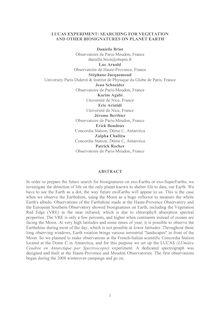
Documents
LUCAS EXPERIMENT: SEARCHING FOR VEGETATION AND OTHER BIOSIGNATURES ON PLANET EARTH Danielle Briot Observatoire de Paris Meudon France danielle fr Luc Arnold Observatoire de Haute Provence France Stéphane Jacquemoud University Paris Diderot Institut de Physique du Globe de Paris France Jean Schneider Observatoire de Paris Meudon France Karim Agabi Université de Nice France Eric Aristidi Université de Nice France Jérome Berthier Observatoire de Paris Meudon France Erick Bondoux Concordia Station Dôme C Antarctica Zalpha Challita Concordia Station Dôme C Antarctica Patrick Rocher Observatoire de Paris Meudon France ABSTRACT In order to prepare the future search for biosignatures on exo Earths or exo SuperEarths we investigate the detection of life on the only planet known to shelter life to date our Earth We have to see the Earth as a dot the way future exoEarths will appear to us This is the case when we observe the Earthshine using the Moon as a huge reflector to measure the whole Earth's albedo Observations of the Earthshine made at the Haute Provence Observatory and the European Southern Observatory showed biosignatures on Earth including the Vegetation Red Edge VRE in the near infrared which is due to chlorophyll absorption spectral properties The VRE is only a few percents and higher when continents instead of oceans are facing the Moon At very high latitudes and some times of year it is possible to observe the Earthshine during most of the day which is not possible at lower latitudes Throughout these long observing windows Earth rotation brings various terrestrial landscapes in front of the Moon So we planned to make observations at the French Italian scientific Concordia Station located at the Dome C in Antarctica and for this purpose we set up the LUCAS LUmière Cendrée en Antarctique par Spectroscopie experiment A dedicated spectrograph was designed and built at the Haute Provence and Meudon Observatories The first observations began during the winterover campaign and go on
Danielle Briot

Documents
Rapports de stage
LUCAS EXPERIMENT: SEARCHING FOR VEGETATION AND OTHER BIOSIGNATURES ON PLANET EARTH Danielle Briot Observatoire de Paris Meudon France danielle fr Luc Arnold Observatoire de Haute Provence France Stéphane Jacquemoud University Paris Diderot Institut de Physique du Globe de Paris France Jean Schneider Observatoire de Paris Meudon France Karim Agabi Université de Nice France Eric Aristidi Université de Nice France Jérome Berthier Observatoire de Paris Meudon France Erick Bondoux Concordia Station Dôme C Antarctica Zalpha Challita Concordia Station Dôme C Antarctica Patrick Rocher Observatoire de Paris Meudon France ABSTRACT In order to prepare the future search for biosignatures on exo Earths or exo SuperEarths we investigate the detection of life on the only planet known to shelter life to date our Earth We have to see the Earth as a dot the way future exoEarths will appear to us This is the case when we observe the Earthshine using the Moon as a huge reflector to measure the whole Earth's albedo Observations of the Earthshine made at the Haute Provence Observatory and the European Southern Observatory showed biosignatures on Earth including the Vegetation Red Edge VRE in the near infrared which is due to chlorophyll absorption spectral properties The VRE is only a few percents and higher when continents instead of oceans are facing the Moon At very high latitudes and some times of year it is possible to observe the Earthshine during most of the day which is not possible at lower latitudes Throughout these long observing windows Earth rotation brings various terrestrial landscapes in front of the Moon So we planned to make observations at the French Italian scientific Concordia Station located at the Dome C in Antarctica and for this purpose we set up the LUCAS LUmière Cendrée en Antarctique par Spectroscopie experiment A dedicated spectrograph was designed and built at the Haute Provence and Meudon Observatories The first observations began during the winterover campaign and go on
Danielle Briot
5 pages
English
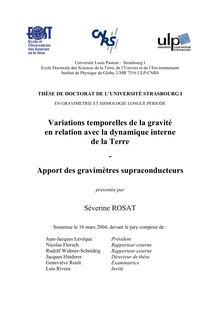
Documents
Université Louis Pasteur Strasbourg I Ecole Doctorale des Sciences de la Terre de l'Univers et de l'Environnement
Séverine Rosat
Collection
{{collectionTitle}}
Collection
{{collectionTitle}}
Collection
{{collectionTitle}}
{{productCategoryLabel}}
{{productTitle}}
{{productAuthors}}
{{productCategoryLabel}}
{{productThemeLabel}}
{{productTitle}}
{{productAuthors}}
{{productPages}}
{{productLanguageIsoCode}}
